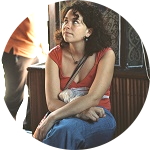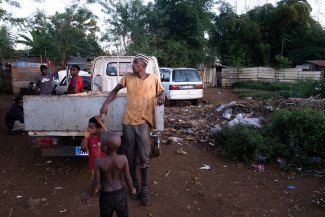Following the destruction of the Calais jungle and the dismantling of numerous illegal camps in the French capital, Paris City Hall has opened a humanitarian centre for foreigners seeking asylum.
At the Porte de la Chapelle in Paris, it is all that you can see, a vast yellow and white plastic dome, erected on 10 November, between the Paris ring road and the tall apartment buildings.
It is surrounded by barriers decorated by artists to make it look “a bit more welcoming”. In front of it, the Republican Security Company (CRS) guard the entrance while exhausted looking exiles come and go, waiting to be allowed in.
Neither an administrative detention centre nor a permanent accommodation centre, this humanitarian centre for unaccompanied men has something of a hybrid status.
“This is an experimental measure. We have only had three months to build this social and architectural project. The real aim is to get them off the streets so that they can think about building their new life” says Bruno Maurel, chairman of Emmaüs Solidarités, the organisation managing the structure.
The government has invested 1.3 million euros to set up the centre and Paris City Hall 6.6 million. The annual running costs (including the salaries of 120 employees) come to 8.6 million euros, of which 7.24 million are paid by the State, which works out at about 40 euros (US$41) per day per person.
The mayor of Grande-Synthe, a town in the north of France, faced with a mass influx of migrants owing to its proximity to England, is the only other one to have erected a similar camp, at the beginning of the year.
Dominique Versini, Paris’s Deputy Mayor, has insisted that the asylum seekers be welcomed “unconditionally”. As a result, in November alone, over 3,000 people were welcomed to the heated dome, averaging about 50 or 60 a day.
The Emmaüs teams carry out a first interview, which is where they can divide the candidates into eligible asylum seekers and the rest. But some associations believe the centre does not resolve the fundamental problem that France faces in receiving refugees.
Their complaint is as follows: “While the intentions that motivated the creation of this centre are praiseworthy, they cannot hide the obvious problem affecting the whole of France: multiple ad hoc, short term solutions are not enough to resolve the humanitarian crisis that these refugees are the victims of. It is first and foremost the consequence of major inadequacies in the reception of refugees caused by delays at State level over the last two decades.”
The men allowed to apply for asylum are housed for five to 10 days in a hall next to the dome that can accommodate up to 400. Living quarters have been designed, in the form of wooden cabins that can take four people. In one month, 1,200 men, mainly Sudanese, Eritreans and Afghans, have been housed there - over a third of the people received in the dome.
Those who do not have the right to asylum are sent to other emergency accommodation services, most of which are already overstretched.
About 300 unaccompanied minors and a hundred families were sent directly to structures designed to receive them.
Sitting on a bench near the canteen, Safik’s eyes are glued to his telephone. Thanks to the internet connection available in the hall, he is able to chat with his mother and sister who have stayed behind in Afghanistan.
He had refused to do military service there, and had run away. After three months on the move, the young man had arrived at the centre about three days earlier, and says he feels well.
“At first I wanted to join my uncle in England” he says, in halting English. “But in the end, I think it is going to be complicated getting there, so I’ll stay in France.”
But not all migrants are sure about what they are doing. Some seem to be here by default. Sam is a case in point. He is an Eritrean taxi driver who paid US$7,000 to get from Libya to Italy. “My wife has been in England with our son for several months now” he says. “I prefer not to ask for asylum in France because I want to join them. For the time being I’ll wait here until things in England get better.”
Out of the group he is living with, in a camp under the Paris sky train, he is the only one who doesn’t want to settle in France.
During their stay, the migrants are given information about the right to asylum. Then, if they decide to apply, they are sent to the national network of Reception and Guidance Centres (Centres d’accueil et d’orientation (CAO). In one month, 774 migrants left the centre for the CAO, vacating their place for others.
“It is a virtuous cycle, based on the turnover between the centre and the other structures” explains Mr. Morel. “But the capacity to receive these migrants has to match up to the task at the national level, otherwise it’s not going to work.” If the CAO system couldn’t cope, or didn’t have the space, the Paris centre could quickly fill up.
The figures are clear: less than half of those who have been received have been given accommodation here. Some migrants are not eligible for asylum – although it is difficult to know how many – but above all it has not been possible to conduct a full individual interview for everyone.
As the flow shows no sign of subsiding, Emmaüs is already looking at how to increase the capacity of the centre, to provide an additional 200 beds. It is all the more urgent given that a new camp has recently been created next to the centre, running counter to the Paris City Hall’s aim of avoiding the construction of camps in the French capital.











